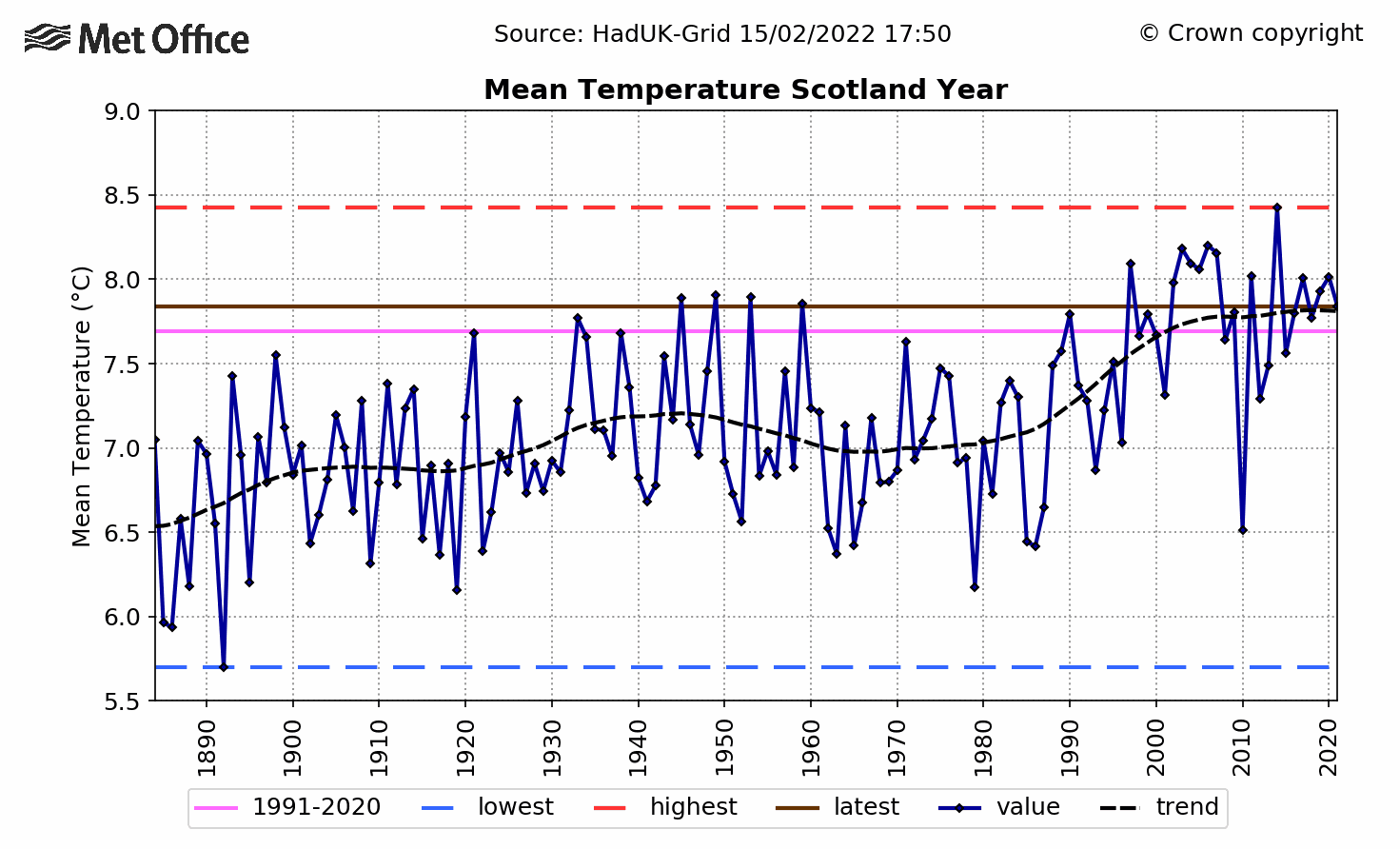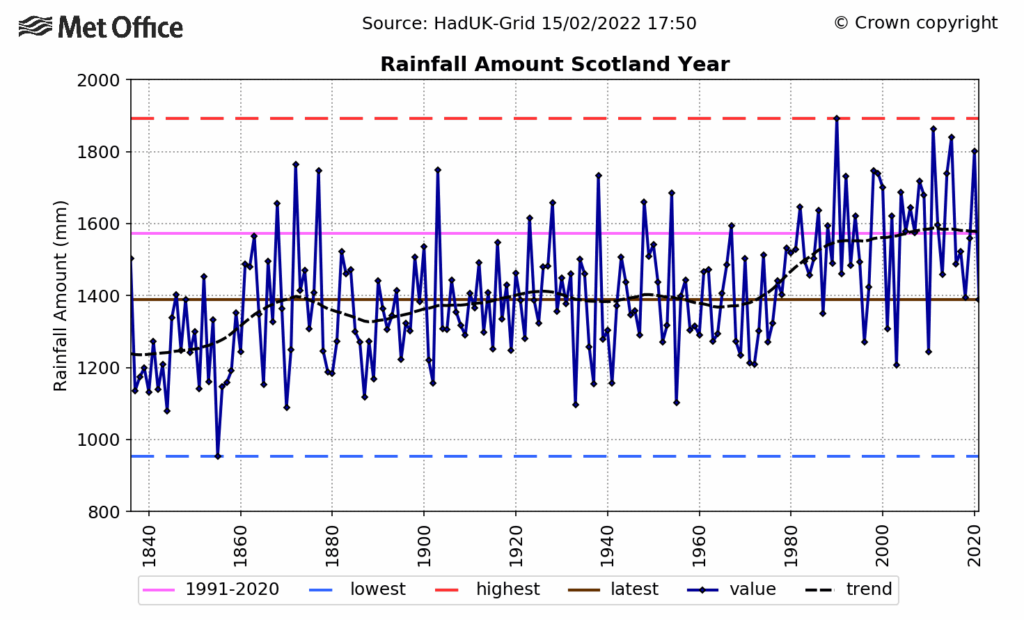Always keen to stay one step ahead of the English, Nicola Sturgeon has set the Scottish Net Zero target at 2045, five years ahead of England’s. No longer can anyone pretend that the climate catastrophe is some abstract event, the Scottish First Minister told the recent COP26 conference in Glasgow. “You only have to see the increasing numbers of severe weather events around the world to know that the climate, and the planet is changing rapidly”, she added.
Alas, it appears some pretence is now required to promote the Scottish Net Zero agenda using the ‘climate fireball’ scare tactic.
According to the Met Office graph (above), the temperature in Scotland has stalled and has barely moved for almost 20 years. Indeed Scotland seems to be leading the way in plateauing measurements. Satellite data show that the global temperature pause is almost eight years long, although, as in Scotland, the start of the slow down can be dated before 2000. Of course, Sturgeon is never going to be short of a bit of bad or severe weather somewhere in the world to point a finger at. And, needless to say, climate change must also be seen as a “feminist” issue.
But old scare habits die hard. Last week, the Government-sponsored Climate Change Committee (CCC) issued some nannying nonsense about tackling climate change in Scotland, and stated that the process had “stalled”. The chairwoman of the CCC adaptation committee Julia King, Baroness Brown of Cambridge, told the BBC that the average temperature in Scotland “has risen by 0.5°C” over the last 30 years. According to the Met Office graph, the figure is around 0.4°C. In addition, King’s figure is clearly cherry picked, since most of the rise occurred in the last century.
Many of the forecasts for future climate change in Scotland were produced in 2018 by the Met Office Hadley Centre. A useful summary of the predictions was compiled by the Scottish Government-funded Adaptation Scotland, and can be seen here. Assuming the current ‘medium-high’ carbon dioxide emissions scenario, it said that temperature would rise by 1.5°C by 2050. By 2080, the temperature could rise to 3°C, with a top limit of 5°C. Back in the real world, the Met Office graph would shoot up nearly vertically with a high point well past this article’s headline. Inaccurate doesn’t even begin to describe it!
Turning to rainfall, the Met Office predicted about 12% extra precipitation by 2050 in winter and around 8% less in summer. These figures, along with those for heat, are of course just guesses made by constantly wrong climate models.
The actual figures from the Met Office show that Scottish rainfall has been stable for over 30 years, albeit with a recent marginal fall. As with the previous chart, both temperature and rainfall showed a rise for a short period from the 1970s. It is likely they were linked – slightly higher temperatures leading to increased water evaporation. A link with CO2, the vital connection that must be proved to justify Net Zero, remains scientifically unproven. The Scottish temperature chart is similar to other northern hemisphere countries. Carbon dioxide rose throughout the 20th century, despite pauses, dips and rises in the temperature. From 1900 to 1940, before mass industrialisation took off, it rose by 5.2%.
For old times’ sake, climate alarmists still promote the fireball narrative but their hearts cannot be in it. The once fashionable global cooling scare of the 1970s was killed off by the small jump in temperatures during the 1980s and 90s. It is likely that a decade of flatlining will do the same to the warming alarm. The more scientists look at the Earth’s climate, the more evidence accumulates that the changes seen since the turn of the 19th century have occurred countless times in the past. The Earth has been much hotter and colder in the past, CO2 levels have been 15 times higher in the atmosphere and plant and animal life has been abundant. Short-term temperature movements are commonplace.
Meanwhile, Scotland is saddled with a nationalist Government supported by green activists that seeks to close down the oil and gas industry, which for a while gave an enormous boost to its fragile economy. In barely 23 years, the Scots plan to warm their homes in the depth of a bitterly cold winter by drawing heat from the outside frozen air and ground. As well, they will be forced to rely on battery cars to safely move around the under-populated wilds of the freezing north. Recently Sturgeon came out against developing the Cambo oil field off the coast of the Shetlands.
It is not as if Scotland does not have enough problems already to contend with. Writing in the Daily Telegraph on Saturday, Camilla Tominey noted that the SNP Government had presided over failure after failure. These included a toxic nationalist debate, falling education and health provisions, rising drug abuse and broken public finances. This has occurred at a time when the funding per person for public services is 30% higher than in England, much of which arises as a result of the Barnett Formula. Perhaps this goes some way to explaining why the SNP “thinks it can afford to run the country like a banana republic”, suggested Tominey.
The all-in energy bet being made in Scotland is for subsidy-hungry, intermittent wind, a process started by Sturgeon’s predecessor Alex Salmond. In 2014, Salmond suggested that Scotland’s green energy resources could power much of Europe. With its natural energy resources the envy of Europe, Scotland, he continued, “could be the Saudi Arabia of renewables”. The bet is being placed despite the local Institution of Engineers and Shipbuilders warning that Scottish green policy was likely to lead to “severe electricity blackouts”.
If only there was a way to harness the windy rhetoric of Scottish politicians, Scotland could light up the globe.
Chris Morrison is the Daily Sceptic’s Environment Editor












To join in with the discussion please make a donation to The Daily Sceptic.
Profanity and abuse will be removed and may lead to a permanent ban.